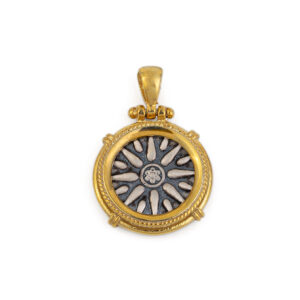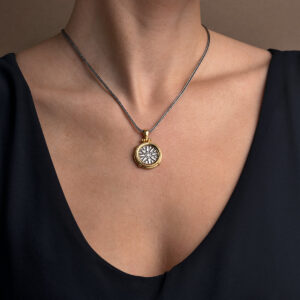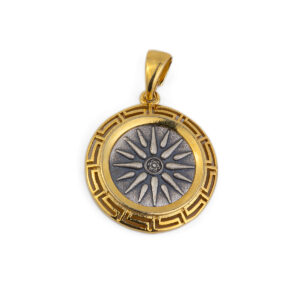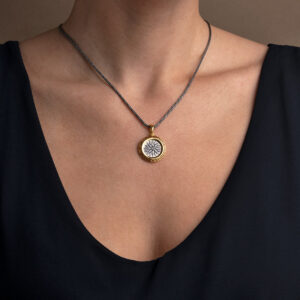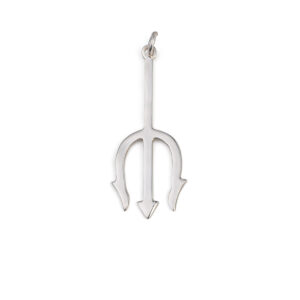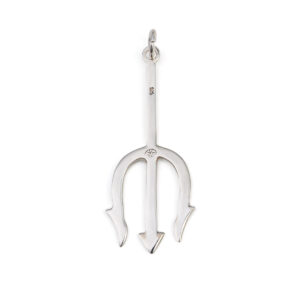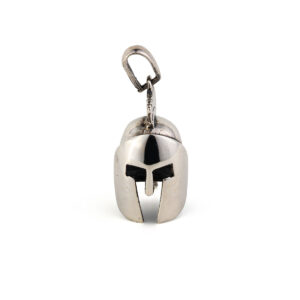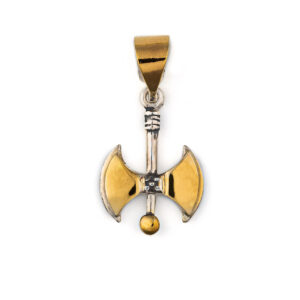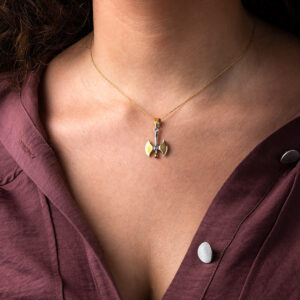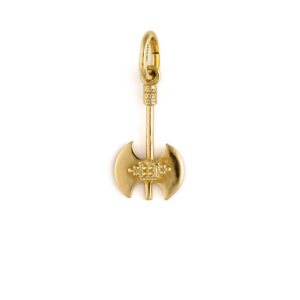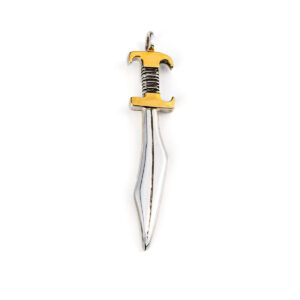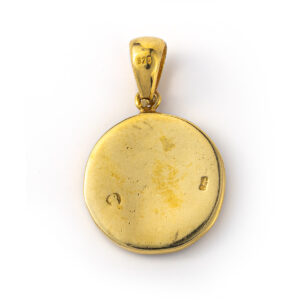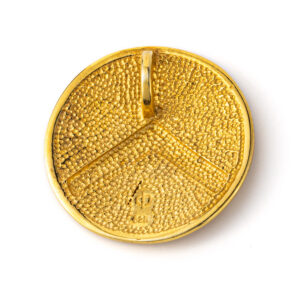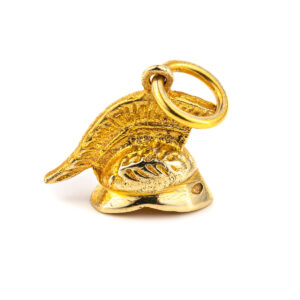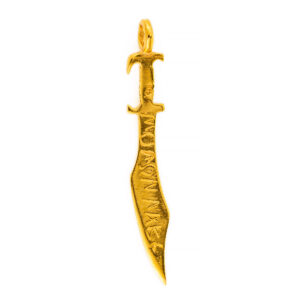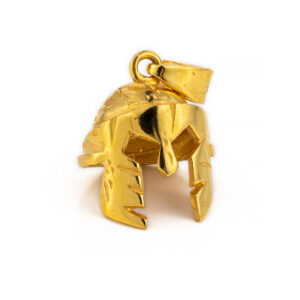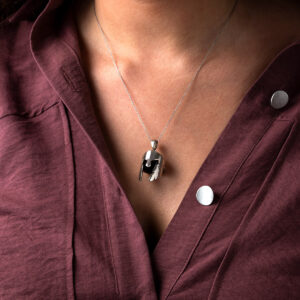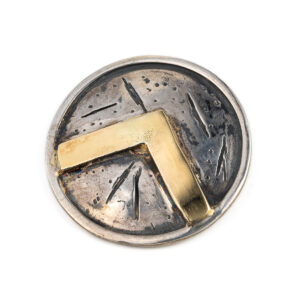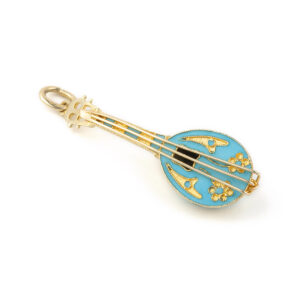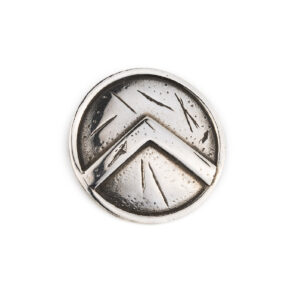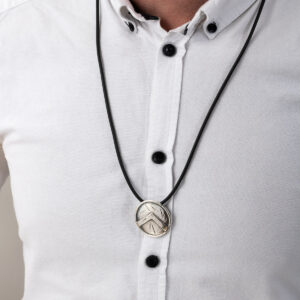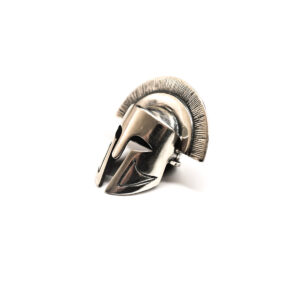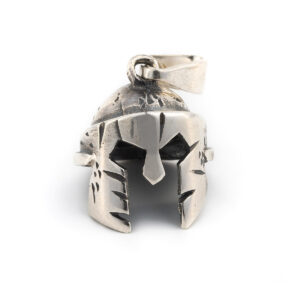Pendants
Vergina Sun Pendant – Sterling Silver and Gold Plated
This pendant illustrates the Vergina symbol.
Made of 925 sterling silver and gold plated.
Handmade in Greece. Explore Heritage Collection
History
The Vergina Sun also known as the “Star of Vergina”, or “Macedonian Star” is a rayed solar symbol appearing in ancient Greek art. The Vergina Sun proper has sixteen triangular rays. The name “Vergina Sun” became widely used after the archaeological excavations in and around the small town of Vergina, in northern Greece, during the late 1970s. In older references, the name “Argead Star” or “Star of the Argeadai” is used for the Sun as the royal symbol of the dynasty of Macedon. There it was depicted on a golden larnax found in a 4th-century BC royal tomb belonging to either Philip II or Philip III of Macedon, the father and half-brother of Alexander the Great, respectively.
Greek Key Vergina Sun Pendant – Sterling Silver and Gold Plated
This pendant illustrates the Vergina symbol.
Made of 925 sterling silver and gold plated.
Handmade in Greece. Explore Heritage Collection
History
The Vergina Sun also known as the “Star of Vergina”, or “Macedonian Star” is a rayed solar symbol appearing in ancient Greek art. The Vergina Sun proper has sixteen triangular rays. The name “Vergina Sun” became widely used after the archaeological excavations in and around the small town of Vergina, in northern Greece, during the late 1970s. In older references, the name “Argead Star” or “Star of the Argeadai” is used for the Sun as the royal symbol of the dynasty of Macedon. There it was depicted on a golden larnax found in a 4th-century BC royal tomb belonging to either Philip II or Philip III of Macedon, the father and half-brother of Alexander the Great, respectively.
Medusa Pendant – Sterling Silver
Made of 925° sterling silver.
Handmade item. Explore Heritage Collection
Medusa, in Greek mythology, the most famous of the monster figures known as Gorgons, is generally described as a winged female with living venomous snakes in place of hair; unlike the Gorgons, she was sometimes represented as very beautiful. According to Hesiod and Aeschylus, she lived and died on an island named Sarpedon, somewhere near Cisthene. Medusa was beheaded by the hero Perseus, who thereafter used her head, which retained its ability to turn onlookers to stone, as a weapon until he gave it to the goddess Athena to place on her shield. according to another account; Perseus buried it in the marketplace of Argos. The Labyrinth in ancient Greece was an elaborate, confusing structure designed and built by the legendary artificer Daedalus for King Minos of Crete at Knossos. Its function was to hold the Minotaur. the Minotaur is a mythical creature portrayed in Classical times with the head of a bull and the body of a man. The Minotaur was eventually killed by the Athenian hero Theseus.
Poseidon Trident Pendant – 925 Sterling Silver
Made of 925 sterling silver.
Handmade in Greece
Explore Heritage Collection
History
The trident, which is a spear with three points, or prongs, is the weapon of Poseidon, the god of the sea in classical mythology. Poseidon is often depicted holding the trident, which is associated with his power over the oceans and his ability to control the tides.
Greek Bouzouki Pendant Necklace
Greek Bouzouki Charm pendant decorated with rosette motifs.
Made of sterling silver and gold plated.
Handmade in Greece.
The chain shown is included.
Design inspired by the Greek tradition.
Explore Heritage Collection
History
The Greek bouzouki is a plucked musical instrument of the lute family, called the thabouras or tambouras family. The tambouras existed in ancient Greece as the pandura, and can be found in various sizes and shapes. The bouzouki and the baglamas are the direct descendants. The bouzouki arrived in Greece following the 1919–1922 war in Asia Minor and the subsequent population exchange between Greece and Turkey. The early bouzoukia mostly had three courses. At the end of the 1950s, four-course (tetrachordo) bouzoukia started to gain popularity. The four-course bouzouki was made popular by Manolis Chiotis. Manolis Chiotis was a Greek rebetiko and laiko composer, singer, and bouzouki player. He is considered one of the greatest bouzouki soloists of all time.
Spartan Helmet Pendant – 925 Sterling Silver
Made of 925 sterling silver.
Handmade item.
This pendant represents the helmet of Leonidas. Leonidas was a warrior king of the Greek city-state of Sparta. Arguably, one of the greatest heroes in the history of ancient Greece.
In 480 B.C Leonidas led an army of 6,000 to 7,000 Greeks from many city-states, including 300 Spartans, fought the invading Persian army at the pass of Thermopylae. Leonidas of Sparta blocked the only road through which the massive army of Xerxes could pass. The Persians succeeded in defeating the Greeks but sustained heavy losses. A local resident named Ephialtes led the Persian general by a mountain track to the rear of the Greeks. King Leonidas sent away all the Greek troops and stayed behind with 300 Spartans, 400 Thebans, and 700 Thespian volunteers who refused to leave. They were all killed in the battlefield, protecting their homeland.
Spartan Shield Pendant – 925 Sterling Silver
This pendant represents the shield of the Spartans.
Made of 925⁰ sterling silver.
Handmade pendant.
The letter lambda (Λ), standing for Laconia (the administrative capital of Sparta) or Lacedaemon (ancient name for the city of Sparta), which was painted on the Spartans’ shields, was first adopted in the 420s BC, and quickly became widely known Spartan symbol. Military families passed on their shields to each generation as family heirlooms.
Minoan Double Axe Pendant – 14K Yellow Gold and Sterling Silver
Pendant inspired by the Minoan double axe, known as labrys.
Made of 14K Gold and Sterling Silver
Handmade in Greece.
The chain shown is included.
Explore Heritage Collection
History
Labrys is, according to Plutarch, Minoan word for the double headed axe called in Greek πέλεκυς (pélekus). In ancient Crete, the double axe was an important sacred symbol of the Minoan religion. In Crete it never accompanies male gods, but always female goddesses. It seems that it associated with the worship of Mother Earth or Great Goddess.
Minoan Double Axe Pendant – 14K Yellow Gold
170,00€ – 272,00€Pendant inspired by the Minoan double axe, known as labrys.
Made of 14K Gold.
Handmade item.
The chain shown is our 14K Gold Chain in Length 40cm (not included).
Explore Heritage Collection
Labrys is, according to Plutarch, Minoan word for the double-headed axe called in Greek πέλεκυς (pélekus). In ancient Crete, the double axe was an important sacred symbol of the Minoan religion. In Crete it never accompanies male gods, but always female goddesses. It seems that it is associated with the worship of Mother Earth or Great Goddess.
As in all handmade items, there may be small differences in weight and dimensions and this is what makes them unique and precious.
Minoan Axe Pendant
170,00€ – 255,00€Pendant inspired by the Minoan double axe, known as labrys.
Made of 14K Gold.
Handmade item.
As in all handmade items, there may be small differences in weight and dimensions and this is what makes them unique and precious.
The chain shown is our 14K Gold Chain in Length 40cm (not included).
Explore Heritage Collection
Labrys is, according to Plutarch, Minoan word for the double-headed axe called in Greek πέλεκυς (pélekus). In ancient Crete, the double axe was an important sacred symbol of the Minoan religion. In Crete it never accompanies male gods, but always female goddesses. It seems that it is associated with the worship of Mother Earth or Great Goddess.
Spartan Sword Pendant – 14K Gold and Sterling Silver
Leonidas sword handmade pendant.
Made of 14K Gold and 925⁰ sterling silver.
The chain shown is our 925 Sterling Silver Byzantine Chain in Length 50cm (not included).
Explore Heritage Collection
History
On the reverse side is the inscription “μολών λαβέ” which means “come to get”. This phrase was the answer to Xerxes when he asked him to hand over the arms of the defending Greeks to the Thermopylae. Leonidas was a warrior king of the Greek city-state of Sparta. Arguably, one of the greatest heroes in the history of ancient Greece. In 480 B.C Leonidas led an army of 6,000 to 7,000 Greeks from many city-states, including 300 Spartans, who fought the invading Persian army at the pass of Thermopylae. Leonidas of Sparta blocked the only road through which the massive army of Xerxes could pass. The Persians succeeded in defeating the Greeks but sustained heavy losses. A local resident named Ephialtes led the Persian general by a mountain track to the rear of the Greeks. King Leonidas sent away all the Greek troops and stayed behind with 300 Spartans, 400 Thebans, and 700 Thespian volunteers who refused to leave. They were all killed on the battlefield, protecting their homeland.
Spartan Shield Pendant – Sterling Silver and Gold Plated
This pendant represents the shield of the Spartans.
Made in 925⁰ sterling silver and gold plated.
Handmade pendant.
The letter lambda (Λ), standing for Laconia (the administrative capital of Sparta) or Lacedaemon (ancient name for the city of Sparta), which was painted on the Spartans’ shields, was first adopted in the 420s BC, and quickly became widely known Spartan symbol. Military families passed on their shields to each generation as family heirlooms.
Spartan Shield Pendant – Sterling Silver & Gold Plated
This pendant represents the shield of the Spartans.
Made in 925⁰ sterling silver and gold plated.
Handmade pendant.
The letter lambda (Λ), standing for Laconia (the administrative capital of Sparta) or Lacedaemon (ancient name for the city of Sparta), which was painted on the Spartans’ shields, was first adopted in the 420s BC, and quickly became widely known Spartan symbol. Military families passed on their shields to each generation as family heirlooms.
Spartan Shield Pendant
The 300 Spartans Shield.
This pendant represents the shield of Leonidas. Leonidas was a warrior king of the Greek city-state of Sparta. Arguably, one of the greatest heroes in the history of ancient Greece.
In 480 B.C Leonidas led an army of 6,000 to 7,000 Greeks from many city-states, including 300 Spartans, who fought the invading Persian army at the pass of Thermopylae. Leonidas of Sparta blocked the only road through which the massive army of Xerxes could pass. The Persians succeeded in defeating the Greeks but sustained heavy losses. A local resident named Ephialtes led the Persian general by a mountain track to the rear of the Greeks. King Leonidas sent away all the Greek troops and stayed behind with 300 Spartans, 400 Thebans, and 700 Thespian volunteers who refused to leave. They were all killed on the battlefield, protecting their homeland.
Made in 925⁰ sterling silver and gold plated.
Handmade pendant.
Spartan Helmet Pendant – 14K Yellow Gold
408,00€Pendant with the Spartan helmet.
Made in 14k yellow gold.
The chain shown is our 14K Gold Chain in Length 40cm (not included).
Used as a charm or as a pendant.
The ancient helmets were used to protect the warriors during the war.
As in all handmade items there may be small differences in weight and dimensions and this is what makes them unique and precious.
Leonidas Spartan Sword Pendant
Leonidas Spartan Sword Pendant
Handmade pendant sword in 925⁰ sterling silver and gold plated.
On the reverse side is the inscription “μολών λαβέ” which means “come to get”. This phrase was the answer to Xerxes when he asked him to hand over the arms of the defending Greeks to the Thermopylae. Leonidas was a warrior king of the Greek city-state of Sparta. Arguably, one of the greatest heroes in the history of ancient Greece. In 480 B.C Leonidas led an army of 6,000 to 7,000 Greeks from many city-states, including 300 Spartans, who fought the invading Persian army at the pass of Thermopylae. Leonidas of Sparta blocked the only road through which the massive army of Xerxes could pass. The Persians succeeded in defeating the Greeks but sustained heavy losses. A local resident named Ephialtes led the Persian general by a mountain track to the rear of the Greeks. King Leonidas sent away all the Greek troops and stayed behind with 300 Spartans, 400 Thebans, and 700 Thespian volunteers who refused to leave. They were all killed on the battlefield, protecting their homeland.
Spartan Helmet Pendant – Sterling Silver & gold plated
Replica of the helmet of Spartan King Leonidas.
Leonidas was a warrior king of the Greek city-state of Sparta. In 480 B.C Leonidas led an army of 6,000 to 7,000 Greeks from many city-states, including 300 Spartans, fought the invading Persian army at the pass of Thermopylae. Leonidas of Sparta blocked the only road through which the massive army of Xerxes could pass. The Persians succeeded in defeating the Greeks but sustained heavy losses. A local resident named Ephialtes led the Persian general by a mountain track to the rear of the Greeks. King Leonidas sent away all the Greek troops and stayed behind with 300 Spartans, 400 Thebans, and 700 Thespian volunteers who refused to leave. They were all killed in the battlefield, protecting their homeland.
Handmade pendant made from 925⁰ sterling silver and gold plated.
Double Headed Axe Pendant – 925 Sterling Silver
Labrys Axe Pendant. Labrys is, according to Plutarch, Minoan word for the double headed axe called in Greek πέλεκυς (pélekus). In ancient Crete, the double axe was an important sacred symbol of the Minoan religion. In Crete it never accompanies male gods, but always female goddesses. It seems that it associated with the worship of Mother Earth or Great Goddess.
Design inspired by Ancient Greece.
Made of 925⁰ sterling silver.
Handmade pendant.
The chain shown is our Sterling Silver Cable Chain – Length 45 cm (not included).
300 Spartans Shield Pendant – 14k Gold and Sterling silver
The 300 Spartans Shield.
Made in 14k gold and 925⁰ sterling silver.
Handmade pendant.
This pendant represents the shield of Leonidas. Leonidas was a warrior king of the Greek city-state of Sparta. Arguably, one of the greatest heroes in the history of ancient Greece.
In 480 B.C Leonidas led an army of 6,000 to 7,000 Greeks from many city-states, including 300 Spartans, who fought the invading Persian army at the pass of Thermopylae. Leonidas of Sparta blocked the only road through which the massive army of Xerxes could pass. The Persians succeeded in defeating the Greeks but sustained heavy losses. A local resident named Ephialtes led the Persian general by a mountain track to the rear of the Greeks. King Leonidas sent away all the Greek troops and stayed behind with 300 Spartans, 400 Thebans, and 700 Thespian volunteers who refused to leave. They were all killed on the battlefield, protecting their homeland.
14k Yellow Gold Greek Bouzouki Charm with Turquoise Enamel
730,00€Greek Bouzouki Charm with turquoise enamel decorated with rosette motifs.
Made in 14k yellow gold.
Used as a charm or as a pendant.
Handmade in Greece.
Design inspired by the Greek tradition.
Explore Heritage Collection
History
The Greek bouzouki is a plucked musical instrument of the lute family, called the thabouras or tambouras family. The tambouras existed in ancient Greece as the pandura, and can be found in various sizes and shapes. The bouzouki and the baglamas are the direct descendants. The bouzouki arrived in Greece following the 1919–1922 war in Asia Minor and the subsequent population exchange between Greece and Turkey. The early bouzoukia mostly had three courses. At the end of the 1950s, four-course (tetrachordo) bouzoukia started to gain popularity. The four-course bouzouki was made popular by Manolis Chiotis. Manolis Chiotis was a Greek rebetiko and laiko composer, singer, and bouzouki player. He is considered one of the greatest bouzouki soloists of all time.
Spartan Sword Pendant – Sterling Silver
Leonidas sword pendant.
Handmade pendant.
Made of 925⁰ sterling silver.
On the reverse side is the inscription “μολών λαβέ” which means “come to get”. This phrase was the answer to Xerxes when he asked him to hand over the arms of the defending Greeks to the Thermopylae. Leonidas was a warrior king of the Greek city-state of Sparta. Arguably, one of the greatest heroes in the history of ancient Greece. In 480 B.C Leonidas led an army of 6,000 to 7,000 Greeks from many city-states, including 300 Spartans, who fought the invading Persian army at the pass of Thermopylae. Leonidas of Sparta blocked the only road through which the massive army of Xerxes could pass. The Persians succeeded in defeating the Greeks but sustained heavy losses. A local resident named Ephialtes led the Persian general by a mountain track to the rear of the Greeks. King Leonidas sent away all the Greek troops and stayed behind with 300 Spartans, 400 Thebans, and 700 Thespian volunteers who refused to leave. They were all killed on the battlefield, protecting their homeland.
Spartan Shield Pendant – 925 Sterling Silver
This pendant represents the shield of Leonidas.
Made of 925⁰ sterling silver.
Handmade pendant.
The cord is included with the large size
Leonidas was a warrior king of the Greek city-state of Sparta. Arguably, one of the greatest heroes in the history of ancient Greece. In 480 B.C Leonidas led an army of 6,000 to 7,000 Greeks from many city-states, including 300 Spartans, who fought the invading Persian army at the pass of Thermopylae. Leonidas of Sparta blocked the only road through which the massive army of Xerxes could pass. The Persians succeeded in defeating the Greeks but sustained heavy losses. A local resident named Ephialtes led the Persian general by a mountain track to the rear of the Greeks. King Leonidas sent away all the Greek troops and stayed behind with 300 Spartans, 400 Thebans, and 700 Thespian volunteers who refused to leave. They were all killed on the battlefield, protecting their homeland.
Spartan Helmet Pendant – 925 Sterling Silver
Ancient Greek officer’s helmet from the famous city of Sparta.
Sparta or Lacedaemon was a prominent city-state in ancient Greece in south-eastern Peloponnese. Spartan hoplites were often depicted bearing a transverse horsehair crest on their helmet, which was possibly used to identify officers. In the Archaic period, Spartans were armored with flanged bronze cuirasses, leg greaves, and a helmet, often of the Corinthian type.
Made of 925⁰ sterling silver.
Handmade item.
Leonidas Helmet Pendant – 925 Sterling Silver
Replica of the helmet of Spartan King Leonidas.
Handmade pendant of 925⁰ sterling silver.
The chain shown is our Sterling Silver Cable Chain – Length 45 cm (not included).
Leonidas was a warrior king of the Greek city-state of Sparta. In 480 B.C Leonidas led an army of 6,000 to 7,000 Greeks from many city-states, including 300 Spartans, who fought the invading Persian army at the pass of Thermopylae. Leonidas of Sparta blocked the only road through which the massive army of Xerxes could pass. The Persians succeeded in defeating the Greeks but sustained heavy losses. A local resident named Ephialtes led the Persian general by a mountain track to the rear of the Greeks. King Leonidas sent away all the Greek troops and stayed behind with 300 Spartans, 400 Thebans, and 700 Thespian volunteers who refused to leave. They were all killed on the battlefield, protecting their homeland.

